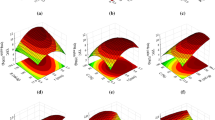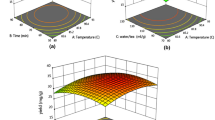Abstract
The beverage obtained from the yerba mate tea, besides being the most consumed in Brazil, has high concentrations of chlorogenic acids. In this study, a central composite design was employed to establish the best infusion time, temperature and water volume to maximize the extraction of chlorogenic acids 5-caffeoylquinic (5CQ), 3.4-dicaffeoylquinic (3.4 DQ), 3.5-dicaffeoylquinic (3.5 DQ) and 4.5-dicaffeoylquinic (4.5 DQ), from the leaves and stems of yerba mate tea (beverage ready for consumption). Analyses were performed by high-performance liquid chromatography and the optimum conditions were obtained through the use of the desirability function of Derringer and Suich. The maximum chlorogenic acids content in the beverage was obtained when the infusion was prepared with 2 g of mate tea, in 300 mL of water at 95 °C, under infusion for 16 min. The optimal conditions were applied for the preparation of beverages from 15 commercial samples of yerba mate tea, and it was observed that the sum of the concentration of the four compounds showed variation of up to 79 times between the average of the samples, which can be attributed to climatic conditions of cultivation of the plant and/or of processing.
Similar content being viewed by others
References
Chang K (2015) World tea production and trade: current and future development. FAO Intergovernmental Group on Tea. Available: http://www.fao.org/3/a-i4480e.pdf. Accessed Mar 2017
IBGE (2009) Instituto Brasileiro de Geografia e Estatística. Pesquisa de orçamentos familiares. http://www.ibge.gov.br/home/default.php. Accessed 12 Dec 2009
Marx F, Janssens MJJ, Urfer P, Scherer R (2003) Caffeine and theobromine composition of mate (Ilex paraguariensis) leaves in five plantations of Misiones, Argentina. Plant Foods Hum Nutr 58:1–8
Arçari DP, Bartchewsky W, Santos TWD, Oliveira KA, Funck A, Pedrazzoli J, MFFd S, Saad MJ, Bastos DHM, Gambero A, Carvalho PO, Ribeiro ML (2009) Antiobesity effects of yerba mate extract (Ilex paraguariensis) in high-fat diet-induced obese mice. Obesity 17(12):2127–2133. doi:10.1038/oby.2009.158
Gugliucci A, Bastos DHM, Schulze J, Souza MFF (2009) Caffeic and chlorogenic acids in Ilex paraguariensis extracts are the main inhibitors of AGE generation by methylglyoxal in model proteins. Fitoterapia 80(6):339–344. doi:10.1016/j.fitote.2009.04.007
Mullen W, Nemzer B, Ou B, Stalmach A, Hunter J, Clifford MN, Combet E (2011) The antioxidant and chlorogenic acid profiles of whole coffee fruits are influenced by the extraction procedures. J Agric Food Chem 59(8):3754–3762. doi:10.1021/jf200122m
Boaventura BCB, Di Pietro PF, Stefanuto A, Klein GA, de Morais EC, de Andrade F, Wazlawik E, da Silva EL (2012) Association of mate tea (Ilex paraguariensis) intake and dietary intervention and effects on oxidative stress biomarkers of dyslipidemic subjects. Nutrition 28(6):657–664. doi:10.1016/j.nut.2011.10.017
Gosmann G, Barlette AG, Dhamer T, Arçari DP, Santos JC, Carmargo ER, Acedo S, Gambero A, Gnoatto SCB, Ribeiro ML (2012) Phenolic compounds from Maté (Ilex paraguariensis) inhibit adipogenesis in 3T3-L1 preadipocytes. Plant Foods Hum Nutr 67:156–161. doi:10.1007/s11130-012-0289-x
Hongli G, Zhaochun L, Wenju W, Xiaolan Q, Meihua C (2013) Aqueous extract of yerba mate tea lowers atherosclerotic risk factors in a rat hyperlipidemia model. Phytother Res 27(8):1225–1231. doi:10.1002/ptr.4856
Budryn G, Zaczyńska D, Żyżelewicz D, Grzelczyk J, Zduńczyk Z, Juśkiewicz J (2017) Influence of the form of administration of chlorogenic acids on oxidative stress induced by high fat diet in rats. Plant Foods Hum Nutr. doi:10.1007/s11130-017-0608-3
Lee K, Lee J-S, Jang H-J, Kim S-M, Chang MS, Park SH, Kim KS, Bae J, Park J-W, Lee B, Choi H-Y, Jeong C-H, Bu Y (2012) Chlorogenic acid ameliorates brain damage and edema by inhibiting matrix metalloproteinase-2 and 9 in a rat model of focal cerebral ischemia. Eur J Pharm 689(1–3):89–95. doi:10.1016/j.ejphar.2012.05.028
Abrahão SA, Pereira RGFA, Sousa RV, Lima AR, Crema GP, Barros BS (2013) Influence of coffee brew in metabolic syndrome and type 2 diabetes. Plant Foods Hum Nutr 68:184–189. doi:10.1007/s11130-013-0355-z
Marques V, Farah A (2009) Chlorogenic acids and related compounds in medicinal plants and infusions. Food Chem 113(4):1370–1376. doi:10.1016/j.foodchem.2008.08.086
Rusak G, Komes D, Likić S, Horžić D, Kovač M (2008) Phenolic content and antioxidative capacity of green and white tea extracts depending on extraction conditions and the solvent used. Food Chem 110(4):852–858. doi:10.1016/j.foodchem.2008.02.072
Silveira TFF, Meihart AD, Ballus CA, Godoy HT (2014) The effect of the duration of infusion, temperature, and water volume on the rutin content in the preparation of mate tea beverages: an optimization study. Food Res Int 60:241–245. doi:10.1016/j.foodres.2013.09.024
Komes D, Horžić D, Belščak A, Ganić KK, Vulić I (2010) Green tea preparation and its influence on the content of bioactive compounds. Food Res Int 43(1):167–176. doi:10.1016/j.foodres.2009.09.022
Astill C, Birch MR, Dacombe C, Humphrey PG, Martin PT (2001) Factors affecting the caffeine and polyphenol contents of black and green tea infusions. J Agric Food Chem 49(11):5340–5347. doi:10.1021/jf010759+
Butiuk AP, Martos AM, Adachi O, Hours RA (2016) Study of the chlorogenic acid content in yerba mate (Ilex paraguariensis St. Hil.): effect of plant fraction, processing step and harvesting season. J App Res Medic Arom Plants 3:27–33. doi:10.1016/j.jarmap.2015.12.003
Derringer G, Suich R (1980) Simultaneous optimization of several response variables. J Qual Tech 12(4):214–219
Silveira TFF, Meinhart AD, de Souza TCL, Teixeira Filho J, Godoy HT (2016) Phenolic compounds from yerba mate based beverages – a multivariate optimisation. Food Chem 190:1159–1167. doi:10.1016/j.foodchem.2015.06.031
Saklar S, Ertas E, Ozdemir IS, Karadeniz B (2015) Effects of different brewing conditions on catechin content and sensory acceptance in Turkish green tea infusions. J Food Sci Tech 52(10):6639–6646. doi:10.1007/s13197-015-1746-y
Meinhart AD, Bizzotto CS, Ballus CA, Poloni Rybka AC, Sobrinho MR, Cerro-Quintana RS, Teixeira-Filho J, Godoy HT (2010) Methylxanthines and phenolics content extracted during the consumption of mate (Ilex paraguariensis St. Hil) beverages. J Agric Food Chem 58(4):2188–2193. doi:10.1021/jf903781w
Perva-Uzunalić A, Škerget M, Knez Ž, Weinreich B, Otto F, Grüner S (2006) Extraction of active ingredients from green tea (Camellia sinensis): extraction efficiency of major catechins and caffeine. Food Chem 96(4):597–605. doi:10.1016/j.foodchem.2005.03.015
Horžić D, Komes D, Belščak A, Ganić KK, Iveković D, Karlović D (2009) The composition of polyphenols and methylxanthines in teas and herbal infusions. Food Chem 115(2):441–448. doi:10.1016/j.foodchem.2008.12.022
Vuong QV, Golding JB, Stathopoulos CE, Nguyen MH, Roach PD (2011) Optimizing conditions for the extraction of catechins from green tea using hot water. J Sep Sci 34(21):3099–3106. doi:10.1002/jssc.201000863
De Maria CAB, Trugo LC, De Mariz E, Miranda LS, Salvador E (1998) Stability of 5-caffeoylquinic acid under different conditions of heating. Food Res Int 31(6–7):475–477. doi:10.1016/S0963-9969(99)00015-0
Budryn G, Nebesny E, Podsędek A, Żyżelewicz D, Materska M, Jankowski S, Janda B (2009) Effect of different extraction methods on the recovery of chlorogenic acids, caffeine and Maillard reaction products in coffee beans. Eur Food Res Technol 228(6):913–922. doi:10.1007/s00217-008-1004-x
Dibert K, Cros E, Andrieu J (1989) Solvent extraction of oil chlorogenic acid from green coffee. Part II: kinetic data. J Food Eng 10:199–214
Isolabella S, Cogoi L, López P, Anesini C, Ferraro G, Filip R (2010) Study of the bioactive compounds variation during yerba mate (Ilex paraguariensis) processing. Food Chem 122:695–699. doi:10.1016/j.foodchem.2010.03.039
Heck CI, Schmalko M, Mejia EG (2008) Effect of growing and drying conditions on the phenolic composition of mate teas (Ilex paraguariensis). J Agric Food Chem 56:8394–8403. doi:10.1021/jf801748s
Esmelindro AA, Girardi Jdos S, Mossi A, Jacques RA, Dariva C (2004) Influence of agronomic variables on the composition of mate tea leaves (Ilex paraguariensis) extracts obtained from CO2 extraction at 30 °C and 175 bar. J Agric Food Chem 52(7):1990–1995. doi:10.1021/jf035143u
Tagliazucchi D, Helal A, Verzelloni E, Conte A (2012) The type and concentration of milk increase the in vitro bioaccessibility of coffee chlorogenic acids. J Agric Food Chem 60(44):11056–11064. doi:10.1021/jf302694a
Acknowledgements
Authors thank São Paulo Research Foundation (FAPESP, process no. 2012/12565-0) for financial support to the research and Espaço da Escrita – General Coordination of the University of Campinas – UNICAMP – for the translation services provided.
Author information
Authors and Affiliations
Corresponding author
Ethics declarations
Conflict of Interest
The authors declare that they have no conflicts of interest.
Rights and permissions
About this article
Cite this article
da Silveira, T.F.F., Meinhart, A.D., de Souza, T.C.L. et al. Optimization of the Preparation Conditions of Yerba Mate tea Beverage to Maximize Chlorogenic Acids Extraction. Plant Foods Hum Nutr 72, 219–223 (2017). https://doi.org/10.1007/s11130-017-0613-6
Published:
Issue Date:
DOI: https://doi.org/10.1007/s11130-017-0613-6




